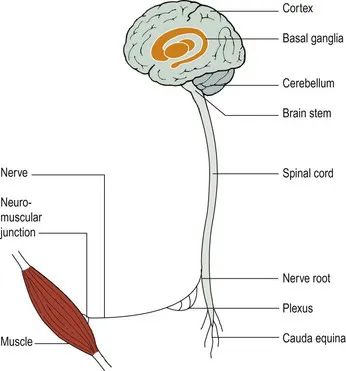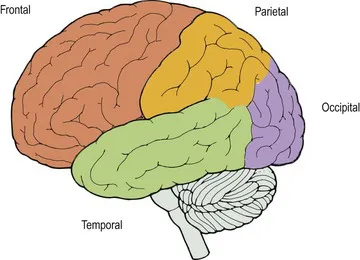
eBook - ePub
Neurology E-Book
An Illustrated Colour Text
Geraint Fuller, Mark R. Manford
This is a test
Buch teilen
- 144 Seiten
- English
- ePUB (handyfreundlich)
- Über iOS und Android verfügbar
eBook - ePub
Neurology E-Book
An Illustrated Colour Text
Geraint Fuller, Mark R. Manford
Angaben zum Buch
Buchvorschau
Inhaltsverzeichnis
Quellenangaben
Über dieses Buch
An introductory textbook of neurology in the Illustrated Colour Text series, making full use of all the usual features of the series - double page spreads, short paragraphs, summary boxes, attractive use of colour etc.
- Clear explanation of neurological examination - often found very taxing by students.
- Demonstrates how to approach common neurological presentations, such as blackouts and numbness, before moving on to a comprehensive coverage of syndromes and diseases.
- Concentrates on the core curriculum which the medical student really needs to know.
- Updated management in the light of new evidence and new drugs most notably in Parkinson's disease, epilepsy and multiple sclerosis.
- Images, particularly MRI scans, updated with more modern and higher resolution images.
- Includes a new double-page spread on Sleep.
- Extra material added on giddiness to include the head thrust test and Epley's manoeuvre.
Häufig gestellte Fragen
Wie kann ich mein Abo kündigen?
Gehe einfach zum Kontobereich in den Einstellungen und klicke auf „Abo kündigen“ – ganz einfach. Nachdem du gekündigt hast, bleibt deine Mitgliedschaft für den verbleibenden Abozeitraum, den du bereits bezahlt hast, aktiv. Mehr Informationen hier.
(Wie) Kann ich Bücher herunterladen?
Derzeit stehen all unsere auf Mobilgeräte reagierenden ePub-Bücher zum Download über die App zur Verfügung. Die meisten unserer PDFs stehen ebenfalls zum Download bereit; wir arbeiten daran, auch die übrigen PDFs zum Download anzubieten, bei denen dies aktuell noch nicht möglich ist. Weitere Informationen hier.
Welcher Unterschied besteht bei den Preisen zwischen den Aboplänen?
Mit beiden Aboplänen erhältst du vollen Zugang zur Bibliothek und allen Funktionen von Perlego. Die einzigen Unterschiede bestehen im Preis und dem Abozeitraum: Mit dem Jahresabo sparst du auf 12 Monate gerechnet im Vergleich zum Monatsabo rund 30 %.
Was ist Perlego?
Wir sind ein Online-Abodienst für Lehrbücher, bei dem du für weniger als den Preis eines einzelnen Buches pro Monat Zugang zu einer ganzen Online-Bibliothek erhältst. Mit über 1 Million Büchern zu über 1.000 verschiedenen Themen haben wir bestimmt alles, was du brauchst! Weitere Informationen hier.
Unterstützt Perlego Text-zu-Sprache?
Achte auf das Symbol zum Vorlesen in deinem nächsten Buch, um zu sehen, ob du es dir auch anhören kannst. Bei diesem Tool wird dir Text laut vorgelesen, wobei der Text beim Vorlesen auch grafisch hervorgehoben wird. Du kannst das Vorlesen jederzeit anhalten, beschleunigen und verlangsamen. Weitere Informationen hier.
Ist Neurology E-Book als Online-PDF/ePub verfügbar?
Ja, du hast Zugang zu Neurology E-Book von Geraint Fuller, Mark R. Manford im PDF- und/oder ePub-Format sowie zu anderen beliebten Büchern aus Medicine & Internal Medicine & Diagnosis. Aus unserem Katalog stehen dir über 1 Million Bücher zur Verfügung.
Information
Organization of the nervous system
The practice of clinical neurology depends on an appreciation of the structure and function of the nervous system. However, a detailed knowledge of neuroanatomy is not essential. This section will outline some of the important neuroanatomy needed for clinical neurology. Some areas, for example the anatomy of the visual system, will be described in the relevant section.
The levels of the nervous system
The nervous system is very complicated, in terms of both its structure and its physiology. Fortunately, when things go wrong they can be categorized on the basis of a relatively simple scheme of neuroanatomy. The nervous system can be thought of as having different levels (Fig. 1). The distribution and type of the clinical problem will often point to the affected level. For example, a patient who is confused must have a disturbance affecting the cerebral hemispheres. There are some situations when the level cannot immediately be determined: for example, a patient with foot drop could have a problem in the peripheral nerve, nerve root, spinal cord or cerebral hemisphere. Terminology used to describe disturbances at different levels is given in Box 1.

Fig. 1 Levels of the nervous system.
Box 1 Terminology
Abnormalities in the different levels of the nervous system can be referred to according to different terms. One commonly used system is described here. The suffix -opathy can be replaced by -itis if there is thought to be an inflammatory basis to the disturbance.










These terms can be combined with one another or other qualifiers to produce descriptions such as focal encephalopathy, or meningoencephalomyelitis (inflammation of the meninges, brain and spinal cord).
The central nervous system
The cerebral hemispheres
The cerebral hemispheres contain the apparatus of higher function. The dominant hemisphere (left in right-handed people) controls speech and the non-dominant hemisphere provides more spatial awareness. Different lobes undertake different functions (Fig. 2):





Fig. 2 Lobes of the brain.
The basal ganglia
The basal ganglia are interconnected deep nuclei including the putamen, caudate, globus pallidum and substantia nigra with complicated interrelations. They are involved in the integration of motor and sensory ...